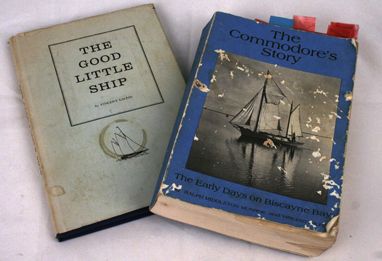The January issue of Practical Sailor has been up on the home page for a while, and inside the issue you’ll find a rather eclectic list of reading material to help sailors through the winter. The reading list includes a reflective memoirs, teen fiction (yes), and a couple of solid how-to books, including a much needed guide to traditional navigation. The featured authors include philosophical delivery skipper John Kretschmer and respected sailing writers Duncan Wells and Paul Heiney. You’ll also see a couple of books geared specifically for women who’ve been drawn to the sea.
I tried to think of another leisure pursuit so blessed with great writers and came up empty. I suppose avid travelers might muster a competitive roster of story-tellers, but some of these writers’ best travel tales are tied to the sea, so we, too, could claim them as our own.
To mark our winter reading issue, I’ve pulled a couple of books from my own bookshelf to share, both of them related to round-bilge sharpies and our review of the Presto 30, which first appeared in the June 2011 issue.
The first is the Commodore’s Story, a memoir of yacht designer Ralph M. Munroe, co-written by his longtime friend Vincent Gilpin. While ostensibly the reflections of a turn-of-the-century sailor, pioneer, and a yacht designer, the The Commodores Story, emerges as an environmentalists paean to the early days on Biscayne Bay. Anyone who has watched progress consume their favorite sailing grounds can identify with Munroes saudade: . . . as I look back there is a color-a tone-a resonance-a life, in those early days and their doings which is now unknown.
The second book is Gilpin’s Good Little Ship. Gilpin initially wrote the book as a tribute to Munroe’s designs, the great volume of line drawings, photographs, and plans that the Hurricane of 1926 swept from Munroe’s home in Coconut Grove, Fla., The Barnacle. But the slim books purpose becomes more far-reaching, ultimately presenting the foundations of a philosophy that is equal parts romantic and pragmatic-the philosophy of the small-boat sailor.
Man has adventured on water in endless ways . . . but of them all, the small craft lies closes to wind and wave, which are the soul and body of the sea, Gilpin writes.
If you’ve ever imagined yourself gunkholing North Americas estuaries in a boat that carries not an ounce of plastic, then you’ll enjoy The Good Little Ship.
Whenever I feel like contemporary yacht designs are losing touch with their raison d etre, these are two of the books I turn to. If you’ve got a great book you’d like to share with other sailors, please let me know at practicalsailor@belvoirpubs.com, or leave a comment below.


































Just about everyone who has been reading sailing books for a number of years has put Joshua Slocum’s Sailing Alone Around the World in their wake. Geoffrey Wolff’s The Hard Way Around – The Passages of Joshua Slocum is a biographical complement to that classic of sea sagas. Wolff captures the drama and romance of Slocum’s life in 216 pages.
Any discussion of sailing books compels me to bring up the “Swallows and Amazons” series by Arthur Ransome. These are great books of kids messing about in boats with only the smallest amount of adult oversight. Written in England in the ’30s, the author’s biography is nearly as interesting as the stories: he smuggled guns for the Bolsheviks, and other adventures. They are rollicking good fun, and can certainly help to keep the winter blues at bay.